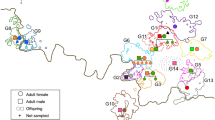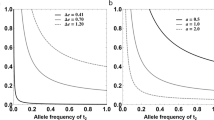Abstract
Females in a variety of species commonly mate with multiple males, and there is evidence that they benefit by producing offspring of higher genetic quality1,2,3; however, the nature of these genetic benefits is debated1,2,3,4. Enhanced offspring survival or quality can result from intrinsic effects of paternal genes—‘good genes’—or from interactions between the maternal and paternal genomes—‘compatible genes’1,2,3,4,5. Evidence for the latter process is accumulating2,6: matings between relatives lead to decreased reproductive success, and the individual level of inbreeding—measured as average heterozygosity—is a strong fitness predictor7,8,9,10,11,12,13. Females should thus benefit from mating with genetically dissimilar males2,14. In many birds, social monogamy restricts mate choice, but females may circumvent this by pursuing extra-pair copulations15,16. Here we show that female blue tits, Parus caeruleus, increase the heterozygosity of their progeny through extra-pair matings. Females thereby produce offspring of higher reproductive value, because less inbred individuals have increased survival chances, a more elaborate male secondary sexual trait (crown colour) and higher reproductive success. The cost of inbreeding may therefore be an important factor driving the evolution of female extra-pair mating.
This is a preview of subscription content, access via your institution
Access options
Subscribe to this journal
Receive 51 print issues and online access
$199.00 per year
only $3.90 per issue
Buy this article
- Purchase on Springer Link
- Instant access to full article PDF
Prices may be subject to local taxes which are calculated during checkout


Similar content being viewed by others
References
Jennions, M. D. & Petrie, M. Why do females mate multiply? A review of the genetic benefits. Biol. Rev. 75, 21–64 (2000)
Tregenza, T. & Wedell, N. Genetic compatibility, mate choice and patterns of parentage: invited review. Mol. Ecol. 9, 1013–1027 (2000)
Zeh, J. A. & Zeh, D. W. Reproductive mode and the genetic benefits of polyandry. Anim. Behav. 61, 1051–1063 (2001)
Brown, J. L. A theory of mate choice based on heterozygosity. Behav. Ecol. 8, 60–65 (1997)
Zeh, J. A. & Zeh, D. W. The evolution of polyandry I: intragenomic conflict and genetic incompatibility. Proc. R. Soc. Lond. B 263, 1711–1717 (1996)
Tregenza, T. & Wedell, N. Polyandrous females avoid costs of inbreeding. Nature 415, 71–73 (2002)
Thornhill, N. W. The Natural History of Inbreeding and Outbreeding: Theoretical and Empirical Perspectives (Univ. Chicago Press, Chicago, 1993)
Kempenaers, B., Adriaensen, F., van Noordwijk, A. J. & Dhondt, A. A. Genetic similarity, inbreeding and hatching failure in blue tits: are unhatched eggs infertile? Proc. R. Soc. Lond. B 263, 179–185 (1996)
Coltman, D. W., Bowen, W. D. & Wright, J. M. Birth weight and neonatal survival of harbour seal pups are positively correlated with genetic variation measured by microsatellites. Proc. R. Soc. Lond. B 265, 803–809 (1998)
Amos, W. et al. The influence of parental relatedness on reproductive success. Proc. R. Soc. Lond. B 268, 2021–2027 (2001)
Hansson, B., Bensch, S., Hasselquist, D. & Akesson, M. Microsatellite diversity predicts recruitment of sibling great reed warblers. Proc. R. Soc. Lond. B 268, 1287–1291 (2001)
Höglund, J. et al. Inbreeding depression and male fitness in black grouse. Proc. R. Soc. Lond. B 269, 711–715 (2002)
Hansson, B. & Westerberg, L. On the correlation between heterozygosity and fitness in natural populations. Mol. Ecol. 11, 2467–2474 (2002)
Pusey, A. & Wolf, M. Inbreeding avoidance in animals. Trends Ecol. Evol. 11, 201–206 (1996)
Petrie, M. & Kempenaers, B. Extra-pair paternity in birds: explaining variation between species and populations. Trends Ecol. Evol. 13, 52–58 (1998)
Blomqvist, D. et al. Genetic similarity between mates and extra-pair parentage in three species of shorebirds. Nature 419, 613–615 (2002)
Kempenaers, B. et al. Extra-pair paternity results from female preference for high-quality males in the blue tit. Nature 357, 494–496 (1992)
Kempenaers, B., Verheyen, G. R. & Dhondt, A. A. Extrapair paternity in the blue tit (Parus caeruleus): female choice, male characteristics, and offspring performance. Behav. Ecol. 8, 481–492 (1997)
Aparicio, J. M., Cordero, P. J. & Veiga, J. P. A test of the hypothesis of mate choice based on heterozygosity in the spotless starling. Anim. Behav. 62, 1001–1006 (2001)
Andersson, S., Örnborg, J. & Andersson, M. Ultraviolet sexual dimorphism and assortative mating in blue tits. Proc. R. Soc. Lond. B 265, 445–450 (1998)
Hunt, S., Cuthill, I. C., Bennett, A. T. D. & Griffiths, R. Preferences for ultraviolet partners in the blue tit. Anim. Behav. 58, 809–815 (1999)
Sheldon, B., Andersson, S., Griffith, S. C., Örnborg, J. & Sendecka, J. Ultraviolet colour variation influences blue tit sex ratios. Nature 402, 874–877 (1999)
Mitton, J. B., Schuster, W. S. F., Cothran, E. G. & De Fries, J. C. Correlation between the individual heterozygosity of parents and their offspring. Heredity 71, 59–63 (1993)
Stockley, P., Searle, J. B., MacDonald, D. W. & Jones, C. S. Female multiple mating behaviour in the common shrew as a strategy to reduce inbreeding. Proc. R. Soc. Lond. B 254, 173–179 (1993)
Dawson, D. A., Hanotte, O., Greig, C., Stewart, I. R. K. & Burke, T. Polymorphic microsatellites in the blue tit Parus caeruleus and their cross-species utility in 20 songbird families. Mol. Ecol. 9, 1941–1944 (2000)
Bensch, S., Price, T. & Kohn, J. Isolation and characterization of microsatellite loci in a Phylloscopus warbler. Mol. Ecol. 6, 91–92 (1997)
Fridolfsson, A. K., Gyllensten, U. B. & Jakobsson, S. Microsatellite markers for paternity testing in the willow warbler Phylloscopus trochilus: high frequency of extra-pair young in an island population. Hereditas 126, 127–132 (1997)
Jamieson, A. The effectiveness of using co-dominant polymorphic allelic series for (1) checking pedigrees and (2) distinguishing full-sib pair members. Anim. Genet. 25, 37–44 (1994)
Pemberton, J. M., Coltman, D. W., Coulson, T. N. & Slate, J. in Microsatellites, Evolution and Applications (eds Goldstein, D. B. & Schlötterer, C.) 151–164 (Oxford Univ. Press, Oxford, 1999)
Turelli, M. & Ginzburg, L. R. Should individual fitness increase with heterozygosity? Genetics 104, 191–209 (1983)
Acknowledgements
We thank D. Blomqvist, S. Griffith, D. Hasselquist, L. Keller, M. Milinski, A. Peters, B. Sheldon, C. Wedekind and D. Zeh for comments on the manuscript; K. Carter, D. Kaulfuss, H. Kunc, K. Peer, A. Pösel and A. Türk for help with field and laboratory work; S. Andersson for computing the colour variables; and H. Winkler (Konrad Lorenz Institute for Comparative Ethology) and R.-T. Klumpp and A. Fojt (Institute of Silviculture, University of Agricultural Sciences, Vienna) for logistic support.
Author information
Authors and Affiliations
Corresponding author
Ethics declarations
Competing interests
The authors declare that they have no competing financial interests.
Rights and permissions
About this article
Cite this article
Foerster, K., Delhey, K., Johnsen, A. et al. Females increase offspring heterozygosity and fitness through extra-pair matings. Nature 425, 714–717 (2003). https://doi.org/10.1038/nature01969
Received:
Accepted:
Issue Date:
DOI: https://doi.org/10.1038/nature01969
This article is cited by
-
Emergence of games from ecological trade-offs: longevity changes strategies for extra-pair mating in birds
Behavioral Ecology and Sociobiology (2023)
-
Using PVA and captive breeding to balance trade-offs in the rescue of the island dibbler onto a new island ark
Scientific Reports (2022)
-
Chemical analysis reveals sex differences in the preen gland secretion of breeding Blue Tits
Journal of Ornithology (2022)
-
High level of extra-pair paternity in the socially monogamous Marsh Tits (Poecile palustris)
Avian Research (2021)
-
Female polyandry dilutes inbreeding in a solitary fast-living hibernator
Behavioral Ecology and Sociobiology (2021)
Comments
By submitting a comment you agree to abide by our Terms and Community Guidelines. If you find something abusive or that does not comply with our terms or guidelines please flag it as inappropriate.



